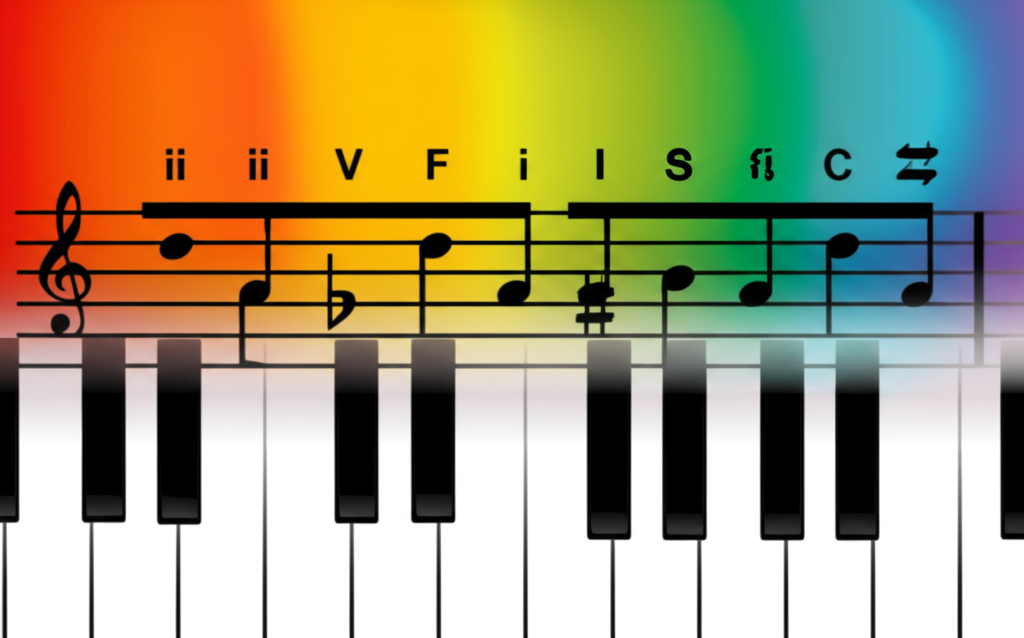
Alternative Rock Progression: The vi-IV-I-V Foundation

b4n1
June 14, 2025, 7:05 p.m.
Alternative Rock Progression: The vi-IV-I-V Foundation
Summary:
The vi-IV-I-V progression is the backbone of alternative rock music, providing an emotional and powerful harmonic foundation that has shaped countless hit songs since the 1990s. This progression creates a distinctive sound that balances melancholy with resolution, making it perfect for the introspective yet anthemic nature of alternative rock.
Keywords:
vi-IV-I-V progression, alternative rock, grunge, post-grunge, chord progression, modern rock, harmonic analysis, songwriting
Introduction:
The vi-IV-I-V progression emerged as a defining characteristic of alternative rock during the 1990s, becoming the harmonic foundation for a generation of music that defined youth culture. Unlike traditional pop progressions that often begin with the tonic, this progression starts with the relative minor, creating an immediate sense of emotional depth and complexity that perfectly matched the introspective nature of alternative rock lyrics and aesthetics.
Harmonic Analysis:
In the key of C major, the vi-IV-I-V progression translates to Am-F-C-G. This progression is particularly effective because it begins with the relative minor (Am), creating an initial sense of uncertainty or melancholy, then moves through the subdominant (F) and tonic (C) before ending on the dominant (G), which creates a sense of anticipation for the cycle to repeat.
Basic vi-IV-I-V in C Major:
The fundamental progression that defines alternative rock:
Notación musical:
Famous Examples:
This progression has been used in countless alternative rock hits, becoming almost synonymous with the genre itself. The progression's versatility allows it to work across different tempos and moods while maintaining its characteristic emotional impact.
Notable Songs Using vi-IV-I-V:
- "Zombie" - The Cranberries
- "Torn" - Natalie Imbruglia
- "Don't Look Back in Anger" - Oasis
- "Iris" - Goo Goo Dolls
- "Basket Case" - Green Day
Emotional Character:
The vi-IV-I-V progression creates a distinctive emotional journey. Starting with the minor vi chord establishes a sense of vulnerability or introspection. The movement to IV provides stability and support, while the I chord offers resolution and hope. The V chord creates tension that pulls back to the beginning, making the progression naturally cyclical and hypnotic.
Rhythmic Variations:
Different rhythmic approaches to the same progression:
Notación musical:
Guitar Voicings and Techniques:
In alternative rock, the vi-IV-I-V progression is typically played using power chords or open chord voicings that emphasize the emotional contrast between major and minor sonorities. The use of distortion and effects pedals further enhances the progression's impact, creating the signature alternative rock sound.
Common Guitar Techniques:
- Power Chords: Emphasizing root and fifth intervals
- Open Voicings: Using open strings for richer harmonies
- Arpeggiation: Breaking chords into individual notes
- Palm Muting: Creating rhythmic emphasis
Variations and Extensions:
Common Variations:
Alternative approaches to the basic progression:
Notación musical:
Cultural Impact:
The vi-IV-I-V progression became more than just a harmonic formula; it became the sonic representation of Generation X's emotional landscape. The progression's balance of melancholy and hope perfectly captured the alternative rock ethos of finding beauty in uncertainty and strength in vulnerability. This harmonic pattern influenced not only rock music but also pop, indie, and even electronic music.
Songwriting Applications:
The vi-IV-I-V progression is particularly effective for verses in alternative rock songs, as it provides a stable yet emotionally engaging foundation for storytelling. Many songwriters use this progression for verses and then move to different progressions for choruses, creating dynamic contrast within the song structure.
Songwriting Tips:
- Verse Foundation: Use for introspective verse sections
- Tempo Flexibility: Works from ballads to uptempo
- Key Modulation: Transpose to match vocal range
- Instrumentation: Layer acoustic and electric guitars
Production Considerations:
In alternative rock production, the vi-IV-I-V progression benefits from careful attention to dynamics and texture. The contrast between the minor vi chord and the major chords can be emphasized through arrangement choices, such as adding strings on the major chords or using different guitar tones for each chord change.
Historical Context:
While the vi-IV-I-V progression existed before alternative rock, it was the genre that truly popularized this harmonic sequence in popular music. The progression's rise to prominence coincided with the mainstream success of alternative rock in the 1990s, when bands like Nirvana, Pearl Jam, and Radiohead brought alternative music to the forefront of popular culture.
Fun Facts:
The vi-IV-I-V progression is sometimes called the "90s progression" because of its widespread use during that decade. Despite its association with alternative rock, the progression has also been used in classical music, particularly by Romantic composers who appreciated its emotional directness. The progression's popularity led to some criticism of its overuse, but its effectiveness in conveying emotion has kept it relevant across multiple decades.
Conclusions:
The vi-IV-I-V progression stands as one of the most influential harmonic sequences in modern popular music. Its perfect balance of emotional complexity and accessibility made it the ideal vehicle for alternative rock's message of finding beauty in imperfection. Understanding this progression is essential for anyone seeking to understand not just alternative rock, but the broader evolution of popular music harmony in the late 20th century. Whether used in its basic form or with sophisticated variations, the vi-IV-I-V progression continues to provide songwriters with a powerful tool for emotional expression.
References:
The Cranberries. (1994). Zombie. Island Records.
Green Day. (1994). Basket Case. Reprise Records.
Stephenson, Ken. (2002). What to Listen for in Rock. Yale University Press.
Moore, Allan F. (2001). Rock: The Primary Text. Ashgate Publishing.


